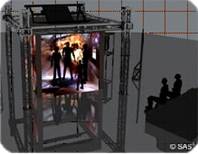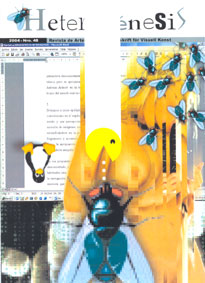|
Nuevo
Arte Mediático
Una paradoja institucional |
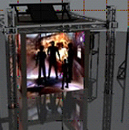 |
|
| New
Media Art Un institutional paradox |
||
|
|
||
|
PAVEL
SEDLAK
|
||
|
|
1. Introduction In the following I will try not only to mediate my experience working as an art theoretician and research administrator at CIANT but also to provide a more theoretical framework allowing for better understanding why we consider new media art to be today’s crucial cultural practice. Before introducing some of our particular projects manifesting diversity of digital culture let me treat first what I suppose to be an inspiring issue that can shed light upon a significance of new media art in general: it is a re-definition of what an institution is in the perspective of philosophy of art and its application to a contemporary artistic creation. It sounds correct that the key player within the last decades which is increasing a complexity of both art and society can be identified as new media. Reception of information and communication technologies has affected and starts to prevailingly dominate all kinds of creative practices. In a shared technological milieu many of former oppositions have acquired a new status: a role of individual creators, for instance, and the activity of formal institutions are now merging together, while a distribution of strategic roles becomes more plausible or even reversible. Bearing this in mind, however, I would like to make one remark: there is indeed something paradoxical in the very concept of an institution that needs to be analyzed in order to explain paradigmatic shifts in the institutional promotion of digital culture. My assumption is that the distinctive features of new media make apparent some of the innovative processes going on between creators, audience, and formal institutions, and that some aspects of art theory in general can be developed in this perspective too. The intention is to introduce a concept of an institution that does correspond with a contemporary cultural praxis and at the same time becomes a possible model of the theoretical reflection on new media art.
|
|
SAS-CUBE
(Projection system for VR) |
|
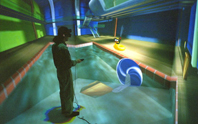 |
|
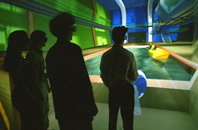 |
|
|
2. Institutional account An
institutional context has become in the 20th century an important aspect
in theorizing and philosophizing art. The emerging concept of an institution,
conceived as an ongoing practice (and therefore contrasted principally
to a formal organization), did reflect creative strategies in the post-war
Avant-garde and, moreover, has started to directly play a crucial role
in both defining and evaluating art. First, article-based attempt by
George Dickie to promote an Institutional Theory of Art appeared as
early as 1969 with a following series of self-defending and corrective
statements including his famous 1984 book The Art Circle. Dickie has
made an institutional account a major issue in the contemporary art
theory, trying to define artworks by the position they occupy within
an institutional context. An informal mechanism of the institution has
a capability to define a cultural system of the ’artworld’
(a term coined by Arthur C. Danto in 1964). Within the artworld various
objects are presented to the agents of the system as candidates for
appreciation according to historical, theoretical or other conventional
and background criteria. This feature is in essence temporal. It aligns
with current reasons operative in governing the choice of objects as
works of art. An identification of the object’s position within
the artworld, respectively, the recognition of its contribution to the
ongoing practice of the cultural system, is of classificatory nature.
There is a logical reason, for each object, why it is or can be a work
of art, but there is not a single trans-historical reason that would
remain independent of contingent preferences typical for different epochs.
Almost all pre-1960s theories of art such as the ones of beauty, taste
or aesthetic attitude, emphasized individual psychology, with dominance
of perception and emotion. These theories of art ignored a cultural
context at all. The influence of semiotics and post-structuralism, which
at the same period offered new referential frameworks for identification
of media as well as institutional functioning, contributed greatly to
new perspectives for art to be studied and interpreted from. It is therefore
no longer an individual psychology, according to Dickie at least, that
can be a guide proper for appreciation and criticism. Understanding
art and assessing its evolutionary qualities is rather a matter of background
mechanisms depending on conventions. A convention is by definition something
plural, that can be done in more than one way: different art media have
different conventions governing spectator participation. This is perhaps
where and how we should enter new spaces for contemporary creation1.
I would thus claim that if promoted as an ongoing practice the institution
is becoming an indispensable space for dynamics of artistic conventions. 3. CIANT - international experience Due
to their critical capacity, independence and mainly flexibility art
centres operating apart from the universities have begun to play a fundamental
role in promoting contemporary artistic creation. It really is symptomatic
especially for new media domain that creative individuals go together
in order to initiate common projects and activities which can hardly
be subsumed under fixed either educational or presentational frameworks.
I would even assume that artistic creation in new media field promotes
itself as an emerging, self-organizing institutional practice. What
is that distinctive about it? New media art is both resistant and productive.
It often resists and many times simply rejects some of the dominant
cultural stereotypes such as art market, formal hierarchies, or a signature.
Moreover, it provides in a generative way good reasons for anybody to
admit the appropriateness of such cultural deconstruction. I would only
make a reference to the costs of a single immersive interactive display
to allow for feature comparison between old and new media venues. On
the other side, through an increasing complexity of new media art practice
concerning its tools and techniques, innovative collaborative formats
become necessary to enable a dialogue between contrasting communities.
In this sense, new media art becomes an institution par excellence shifting
conventions in forms of creation, spectator participation as well as
presentation. |
|
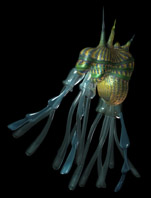 ARAPUCA Proposal by Louis Be
ARAPUCA Proposal by Louis Be |
|
|
4. Electronic Gallery and Laboratory Developing its own solutions for server-client communication with focus on shared interactivity, CIANT has created a number of distributed virtual worlds: the e-AGORA project, for example, is a prototype cultural centre on the Internet, where communication with avatars and real-time streaming of artistic productions takes place in 3D settings. More advanced tools for real-time shared interactivity in a virtual space have been developed within the international eGaLab (Electronic Gallery and Laboratory) project that is based on a need of novel “platforms for artistic development”. Such a platform was created in this joint project of CIANT, CYPRES (Centre Interculturel de Pratiques, Recherches et Echanges Transdisciplinaires) and MIDE (Museo Internacional de Electrografia) being supported by European Commission within CULTURE 2000 programme. If a platform, to quote an artistic director of Medi@terra festival Manthos Santorineos, ”is the combination of technology, a new way of thinking about meeting needs, and the vision of a group of people who are preparing the “space” in which to invite interested persons to develop their own ideas“, we have followed as much as possible this very definition. Since cultural innovation in general is based on a creation and circulation of artefacts, the dynamics of the interactive arts requires completely new competences in preserving, accessing, and experiencing artworks. Traditional mechanisms of curator- and spectatorship are under this condition no more matching an actual state of affairs regarding digital culture. Experimental artistic creativity in the field of new technologies can be viewed nowadays as dominated by (at least) two rather opposing principles: first, it is a flux of tactical and subversive strategies; second, it promotes a transdisciplinary research in the field of art@science as defined by Laurent Mignonneau and Christa Sommerer. With the eGaLab project, we have tried to reflect a voice of artists attempting to resist fixed cultural operation in a framework of market-dependent gallery system, and make use of both these two principles. Artists working with advanced interface and network technologies are no longer producing commodity-like objects. Rather they inhabit a rhizomatic space of the Internet that becomes their cybernetic modus vivendi. Artistic needs and visions in domain of digital culture may now be (re)formulated in terms of shared knowledge and skills. We employed therefore an expertise of several nodes on a cultural map that could shelter creative proposals and initialize needed collaboration across various semantic domains. This is, we have assumed, an ideal role for hybrid art centres operating right between art and research to collaborate. Our overall intention then was to create an experimental milieu where artistic and technological communities would meet and challenged by common tasks they would invent new cooperative formats. This is how a possible shift from singular artwork to an interactive multimedia platform can emerge and in fact it did. What the artists really missed? Mainly, an open technological system that would allow for: *
real-time creation, modification, and exchange of three-dimensional
objects, For these reasons, we have constructed a complex virtual environment implementing an interactive three-dimensional space in VRML (Virtual Reality Modelling Language) that incorporates digital molecules such as animations, texts, digital or digitized photos, video sequences and sound fragments creating a dynamic audiovisual architecture broadcasted and shared in real time on the Internet. This environment enables a collaborative artistic work on multimedia content. Unlike real environments that require physical presence and direct access to the subject of manipulation, new technologies of signal and data transmission render newly conditions of access and enlarge the communities which can share at the same time the same activities. We can be today present in remote spaces thanks to advanced computer generated virtual realities, and even directly manipulate objects using various data suits. Compared to a range of direct manipulation, the possibility to change virtual environment remotely is nevertheless still very marginal. A remote presence and a remote interaction are simply not identical. Although there are already several commercial software solutions available which promote collaborative work on multimedia content, we have to face their common disadvantage: data sharing is always based in a distribution of tasks, i.e. every person involved in a production pipeline has just its own part of work and only those involved in a final composition are able to view a resulting whole. Considering this, we have designed a Laboratory system, where every artist has simultaneous access to all objects in a three-dimensional scene and can continuously observe the activities of other connected participants. The very same type of activity may be shared in the environment, as several persons manipulate the same object in the same time. This approach and development has hopefully opened up a new space for artistic creation. The e-GaLab platform reflects a dynamics of the shared creation in virtual space, so instead of building a repository for finalized works, also its presentation area, the Gallery, inherited a procedural character. The automatic, let us say, curatorial program allows for a recording of all the actions which take place in a shared space of the Laboratory, and stores the scenes as a memory box to evoke any creative moment thereafter. Scenes are mapped upon dynamic cubes located in a navigable space of the Gallery and can be entered separately. Each time a cube is full of scenes recorded from the three-dimensional space of the Laboratory –now ready to be re-entered– a new one is generated automatically. The eGaLab is a networked collaborative virtual environment providing a system where every user at any given moment sees the virtual environment in the same state. This shared state is crucial for all networked virtual environments. |
|
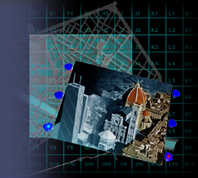 CITY CLUSTER. Proposal by F.A.
CITY CLUSTER. Proposal by F.A. |
|
|
5. Performance between real and virtual world However, the platform is used not only for a shared creation, but also for presentations, including live performances. During a live performance collaborating artists dynamically move the objects and manipulate their visual properties in real time. Since the manipulation using the regular input devices (keyboard and mouse) has inherent limitations, artists demanded integration of more complex devices, including a motion tracking system. For this purpose a simple concept of input device modules was developed. The module receives data from input devices and translates it according to its actual settings to VRML events. The output events can be connected to objects to dynamically change their properties. We implemented an input device module for Polhemus’ ULTRATRAK PRO tracking system that features 12 sensors for position and orientation measuring. The dancer is connected to a motion tracking device while the collaborative virtual space is projected on the screen in a background. The visitors can either come to the venue, watch the performances projected on large screens, or stay at home to watch it directly on their own computers connected to the Internet. As a person being captured by the tracking device moves, the data describing the actions is recorded. The artists are then able to connect an output of the module to objects in the virtual Laboratory, and so produce human-like movements of selected objects. Prague presentation of the eGaLab platform in spring 2003 manifested possibilities of a shared virtual space for experimental creation and live artistic events. Interconnecting virtual reality, motion capture system and contemporary dance we presented one kind of performance using creative and navigational tools developed in the course of the project. A set of these communication tools enabled real-time mixed interaction between real and virtual worlds while sharing a common space on the Internet. This intersection seems to be a great challenge for performing arts in general as it brings along completely new approach towards live stage events and their distribution on variable places. Navigation and shared interactivity have become the key features of the final eGaLab prototype. The importance of this conception and design provides the virtual platform with conditions for becoming a truly useful space for common creative encounters. No part of its virtual territories is fixed. It is, on a contrary, designed with respect to further extension and modification. Groups of artists can now use the platform and collaborate in the same virtual space while working on interactive installations or preparing mixed reality performances, for which tools enabling external interventions have been implemented. At the moment, e-GaLab is still being developed at CIANT and at the University of Maine. It was exhibited last year at the sixth annual online forum Eyebeam dedicated to new paradigms for art making that takes advantage of mobile and distributed technologies. 6. Alternative Realities in Networked Environments In
CIANT, we also advance theoretical studies of new media. Aside the practical
part the solutions of our artistic projects are being supported by contemporary
philosophy, theories of art, research in narrative, and the cognitive
study of emotions. Recently, we have especially focused on the phenomenon
of computer games and their multiple relationships with digital art.
We have set up a Group for the Study of Computer Games between CIANT
and Charles University in Prague and we are now together realizing a
series of lectures and workshops trying to bridge a gap between producers
(designers, programmers and artists) on the one side, and academic researchers
and educators on the other. In a rather extensive circle we have thus
arrived back at theory. Let me now mention briefly one of our current
research projects that can manifest greatly an intrinsic interconnection
between technology, concepts, and creation. At least one aspect of the
20th century philosophy of art which focuses on ways of worldmaking
needs to be contextualized with contemporary views of virtual realities.
As worked out in great detail by Nelson Goodman, cognitive functions
of symbolic systems in general, be it art or science, may help us understand
the role of creative individuals linking humans with machines –
a condition sine qua non of new media art. One of our research challenges
in the domain of Virtual Reality is to introduce and promote a concept
of Alternative Reality that could facilitate more radical experimentations
in digital arts. In our perspective, there emerges a set of themes such
as experimental spatiotemporal orders or principles of causality which
ought to be faced with new aspirations for theoretical validity within
new media aesthetics. But we not only make these themes a subject of
critical study: rather we have identified them as leading topics for
both artistic and technological research within the project ALTERNE
(Alternative Realities in Networked Environments) supported by European
Commission in the Fifth Framework Programme. We try to respond to the
fact that creative expressions in the field of Virtual and Mixed Reality
require abnormally huge expertise in advanced techniques of computing
and visualization but, unfortunately, that artists and especially students
of art schools do not most often have an access to appropriate state-of-the-art
expertise. To avoid a necessity for artists to always start up a design
of virtual environments programming its behaviour and interaction mechanisms
from the scratch, we consider it useful to offer some corrective views
based on the integration of various techniques and the employment of
AI principles that govern causal relations between virtual objects and
thus enhance the integrity of narrative structures. This approach has
been in recent years promoted especially by a leader of the technological
development in ALTERNE, School of Computing at the University of Teesside,
and it brings us all far beyond the visual content alone. We feel like
introducing the virtual responsive environments as intelligent systems
allowing for negotiating of meaning through reversible formats of interaction
with audience. The audience participation can no longer be limited to
imaginative projects only (as in the case of ordinary art forms), but
rather calls for even more complex modalities of performative interaction.
This inevitably raises questions of artistic interests centred round
the real-time capture, analysis and especially interpretation of sensory
data making a spectator a true performer. These issues intervene in
both art and science, they require expertise as much in high-end technologies
as in humanities, and are therefore our prospective research priority. Notes 2 Combined Czech/English version of the catalogue is available at www.ciant.cz. |
|
|
|
|
